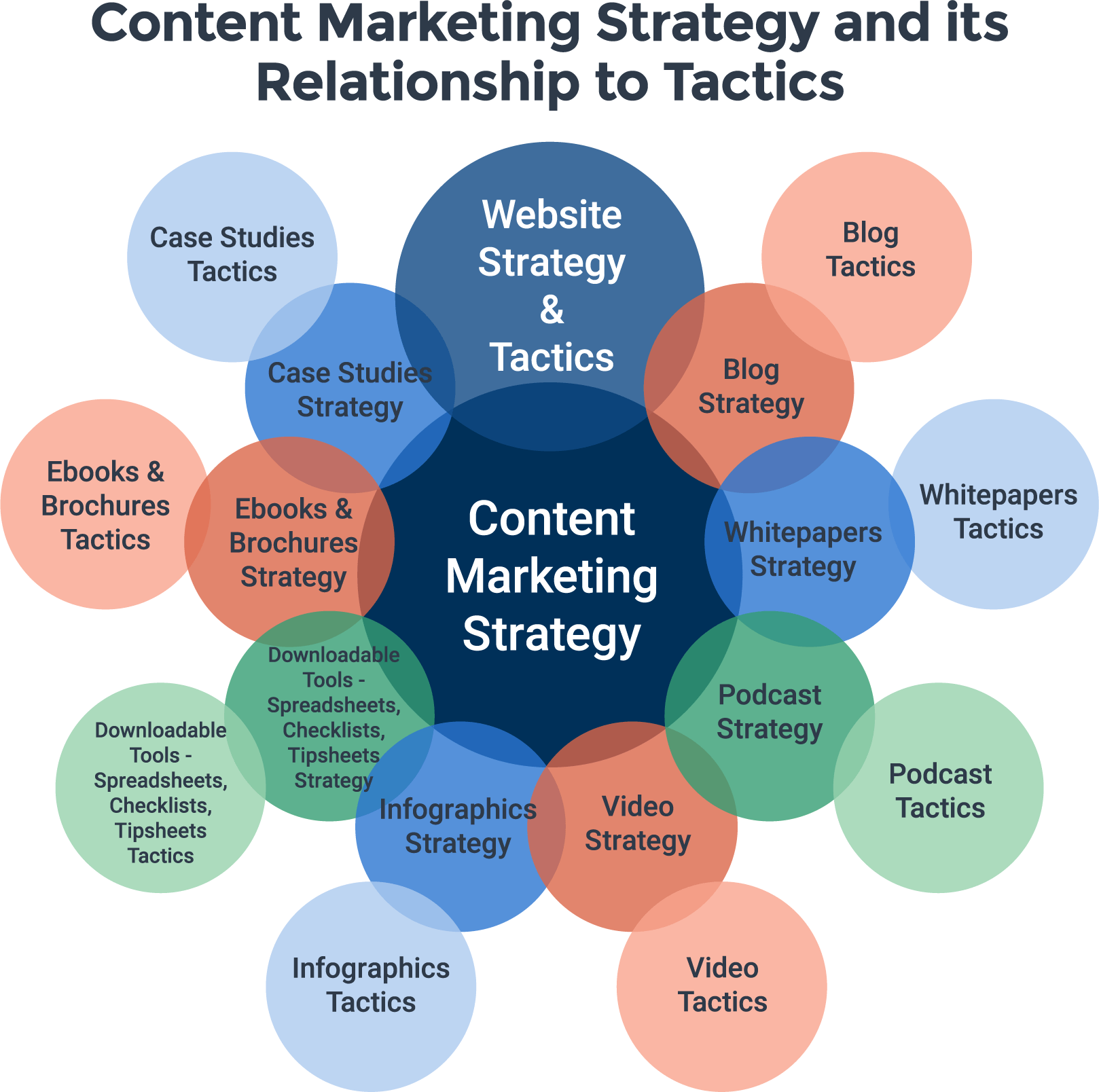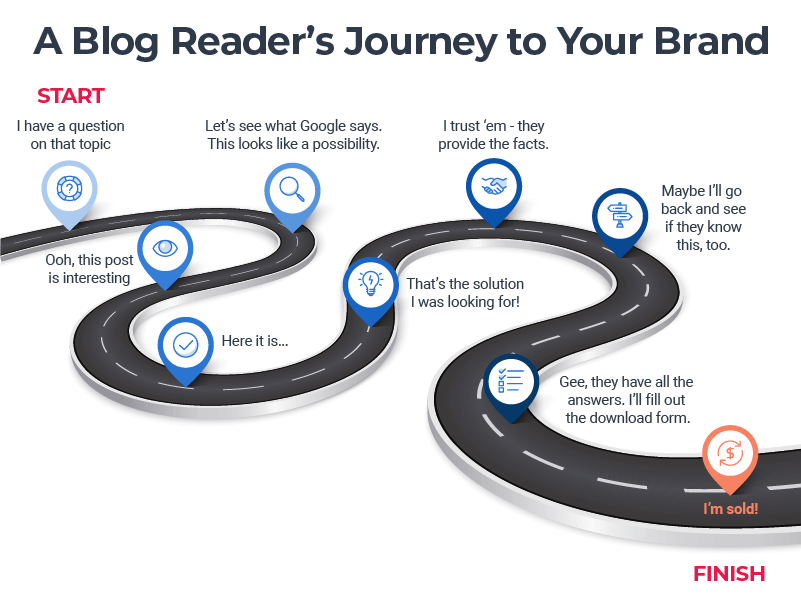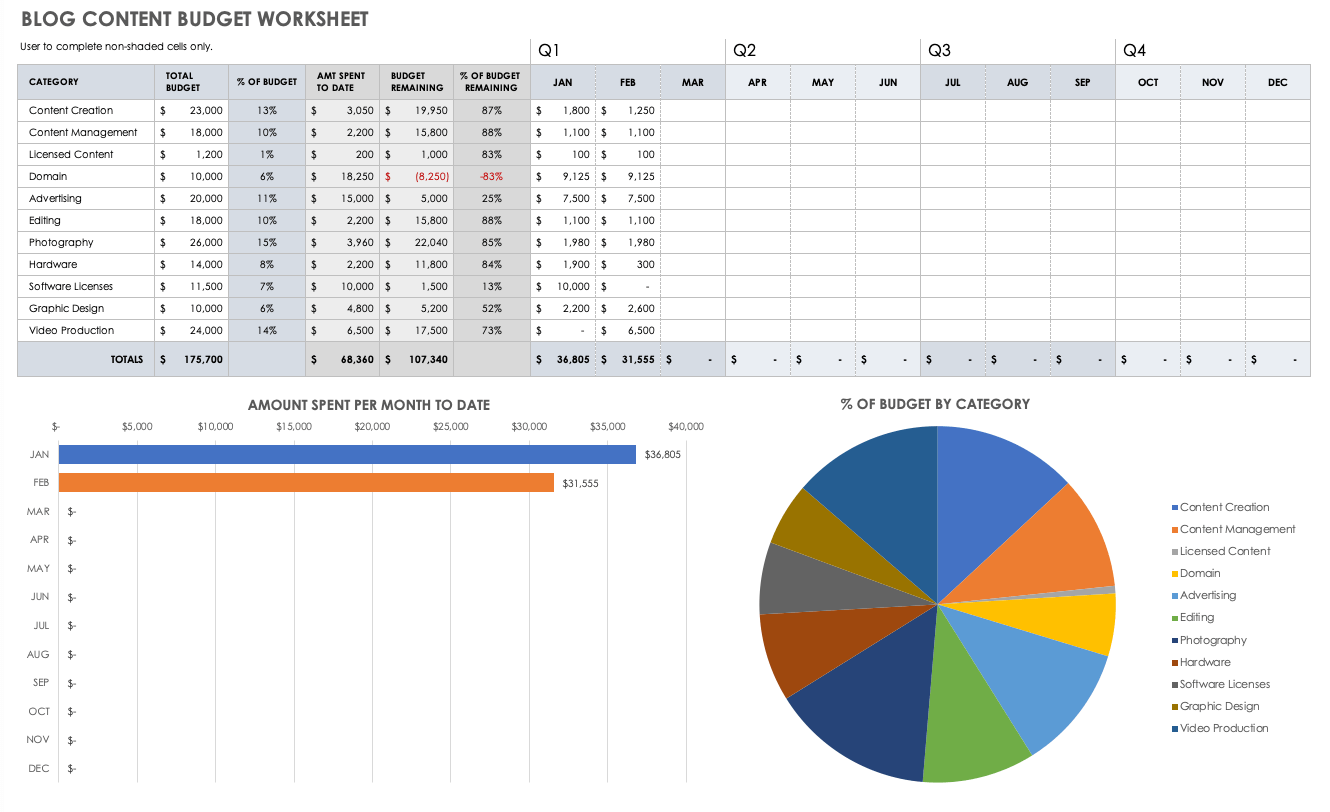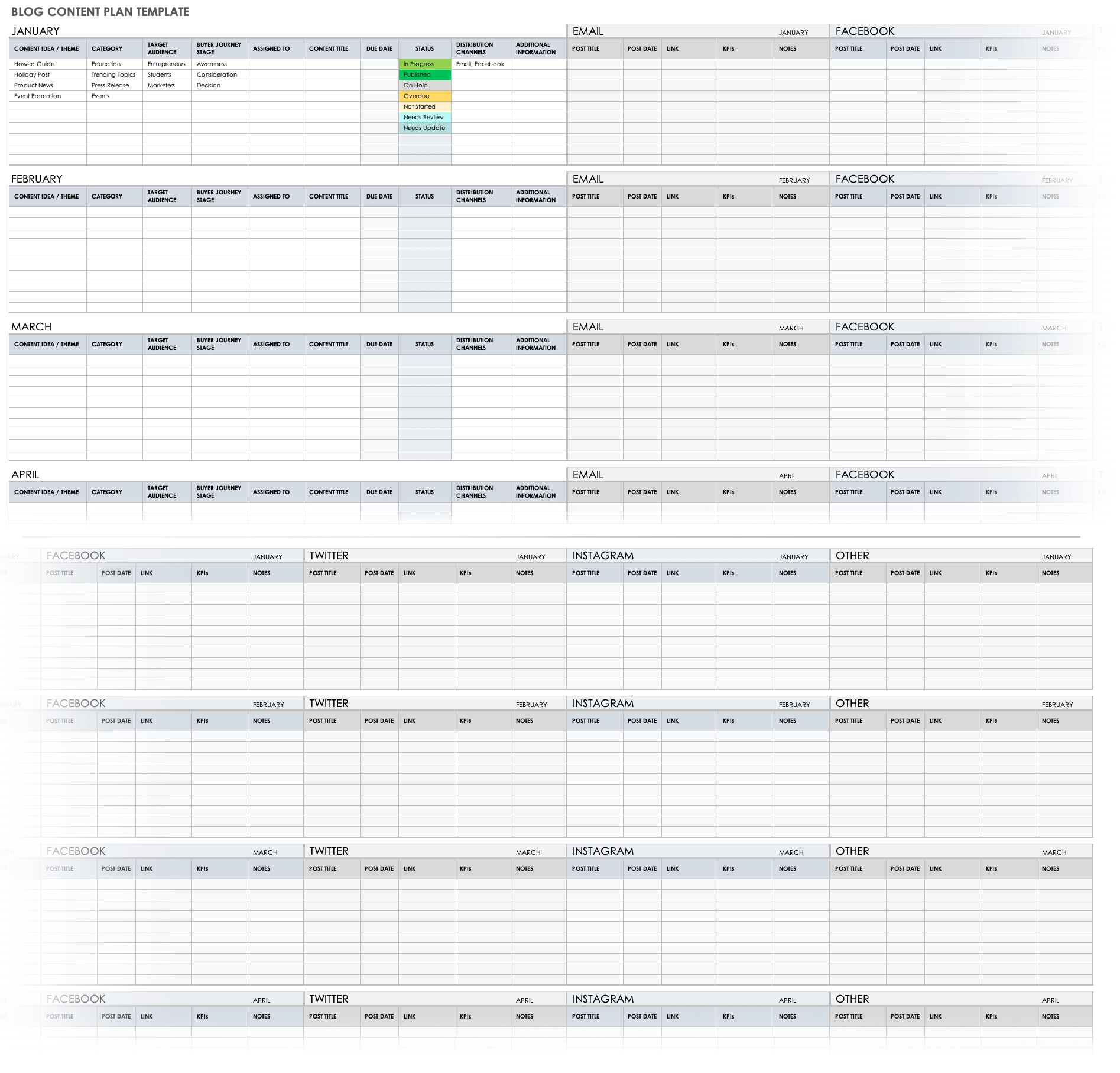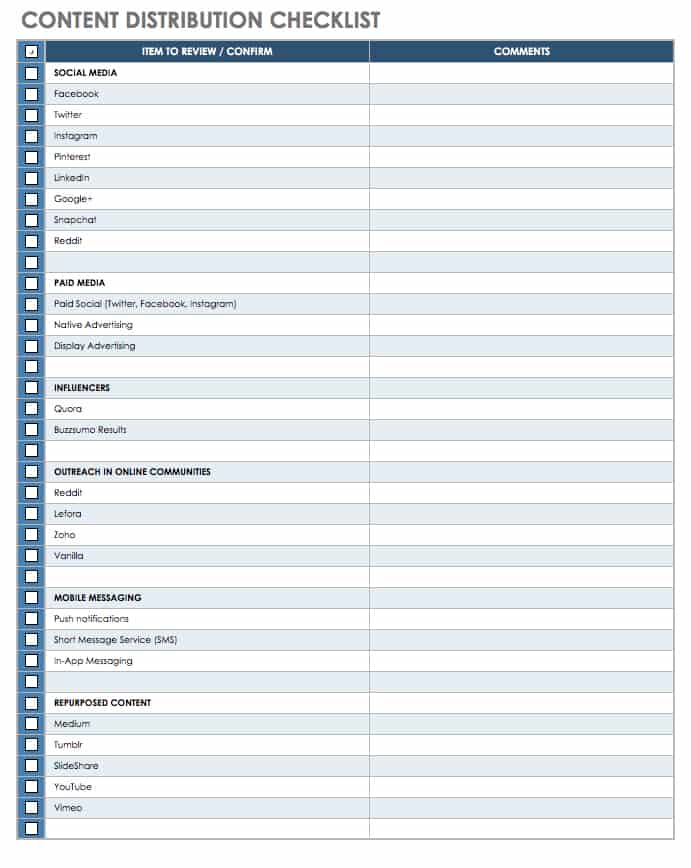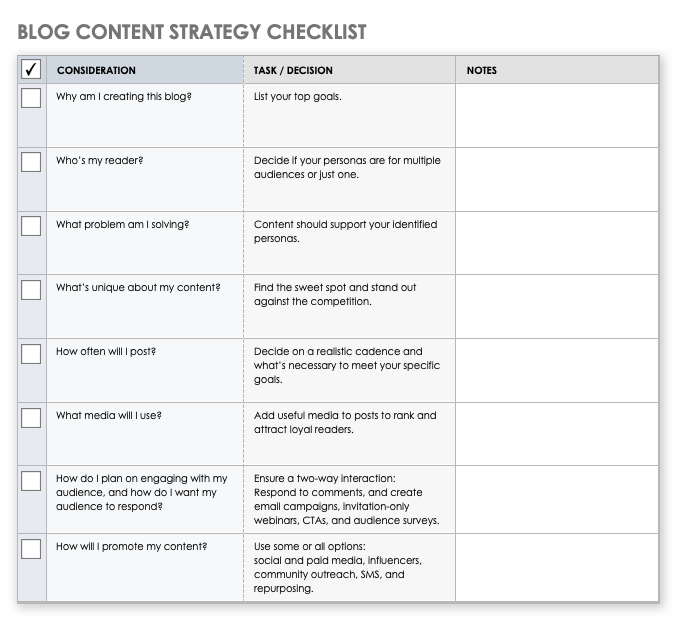What Is a Blog Content Strategy?
A blog content strategy is a method for setting up the type of information (including written, visual, and downloadable media) that you will create for your target audience and share on your blog.
Christoph Trappe, Chief Content Officer of the Authentic Storytelling Project and author of four books, including Content Performance Culture, explains that a blog content strategy requires starting with the right three questions:
- Who are you trying to reach?
- How do you know those individuals care about your stuff?
- What is unique about you and your stories?
Whether you’re a two-person startup or a multinational corporation, the starting point is the same: Look at the overall content marketing strategy and ensure the blog strategy and planned content are aligned.
The Difference between Blog Content Strategy and Regular Content Strategy
People often confuse content strategy and blog strategy, as they both refer to web content. A blog is one element of content strategy, not a standalone entity.
Content marketing strategy centers on creating content that will attract the right audience and lead them down the blog reader’s journey to the ultimate goal of conversion. Blogs are a content strategy tactic that also require a plan.
The Content Marketing Ecosystem
Content marketing consists of multiple tactics, including blogs and case studies, how-to videos, podcasts, e-books and brochures, whitepapers, downloadable assets, infographics, guides, and whitepapers or studies distributed through a website. These tactics are often an ingredient of blog content.
If you’re still working on your overall plan, learn how to create a solid content plan strategy, and simplify the process by using a free content strategy template.
“Creating a successful blog is only a small element of the big content picture,” stresses Payton Moore, a content marketing strategist for Donlen. Moore says thought leaders can be the key to creating meaningful content for readers: strategic consultants, standout customers, and subject matter experts. “Are there timely events or deadlines coming up that our readers will find helpful? Is there a trending topic that we should show our authority on? Will it positively impact organic traffic?”
Moore explains that the acid test is to be honest with yourself about your blog’s worthiness. “Is your blog interesting, or are you just writing to ‘check the box?’”
Why Create a Blog Content Strategy?
A written blog strategy keeps you organized and accountable, and supports success. With a documented content strategy, you’ll spend less time developing ideas and angles, and more time writing.
Blog content strategy creates multiple benefits:
- Organizational Value: “Our blog is one of our top marketing assets,” says Sonia Schecter, Chief Marketing Officer at Marxent, a full-service omnichannel 3D content and visual design platform for e-commerce, sales teams, and enterprise customers. “We've been publishing for nearly a decade. While the company and our goals have changed over time, the blog has created a constant source of value.”
- Insight into Existing Content:
“We start the process of creating our clients' blog strategies by auditing the existing condition of their blogs (if they have one) and their goals,” shares Katie Zillmer, Director of Operations at KitelyTech, a marketing and web development agency. “Not all companies have the same blogging goals. They may need to increase engagement, drive new traffic to the website, or create evergreen posts that increase site value. Understanding goals means we can tailor our approach and provide winning strategy and tactics.” - Strong Framework for Outbound Work: A blog strategy provides structure and enables you to make changes based on new ideas formed from ongoing assessments. Seeing a blog project’s entire scope allows you to sift through tactics and execute on the most potent content. A written schedule creates accountability, improved category planning, and a springboard from which to implement the best ideas.
- New Opportunities:
“When creating a blog strategy, it's helpful and useful to think seasonally or link to events related to your business,” suggests Deidre Grieves, Director of Content for Great Pet Care and Metamorphosis Partners. “Use holidays, events, or the seasons as a way to spark content ideas and tie into newsworthy things happening in the world. While seasonal content shouldn't be the only pillar in your blog strategy, it can offer some moments to map out an editorial calendar.” - Better Service for Target Audiences: Identifying audience needs means you can fine-tune information, assets, and style. As a result, you’ll turn strangers into readers, readers into subscribers, subscribers into engaged and loyal fans, and fans into customers.
To better drive performance for all your planning, select from among our free content marketing templates.
How to Develop a Blog Content Strategy in 9 Steps
Blog content strategy development involves nine steps: goal setting, metrics setting, research, topic definition, budget investment (in time and money), calendar creation, content generation, launch, and analysis.
Here are steps, tools, and expert advice to move you through the process:
1. Set Your Blog Goals: What Do You Want to Achieve?
Be clear about what you want to achieve with your blog. Check those stated goals against your organization’s overall content strategy. The rule of thumb is to choose two to three blogging objectives to direct your content.
Common blog goals help you to do the following:
- Sell: Increase sales or generate leads.
- Educate: Inform prospects and customers about your service or product.
- Update: Share with your customers what’s happening with your business.
- Attract: Find prospects from outside your local area.
- Build: Boost brand awareness.
- Direct: Drive traffic to a brick-and-mortar location.
Experts offer advice on how to meet those goals through blogging:
- Organic Traffic for Startups:
Kris Hughes is a content strategy consultant who helps solopreneurs and startup CEOs demystify and simplify their professional and personal content strategies. Hughes recommends an initially conservative approach. “I recommend that people building a new blog don't spend anything at all until they're driving some traffic organically,” advises Hughes. “The only exception to this rule will be if they have money to burn from a recent fundraise or something similar. If possible, generate content internally and occasionally, hiring a freelancer to post here and there. Hiring freelancers to build your pillar content is a bad idea if they don't have previous experience in your niche and cannot adapt quickly to your voice.” - Go for Volume:
“How do you set goals?” asks Axel DeAngelis, Founder of the business naming startup NameBounce. DeAngelis knows: He grew NameBounce from zero to 35,000 visitors a month via content strategy. “The best goals to set at the outset are related to volume. You can't control Google's search algorithm, but you can control how much you write. At the start of the project, it's also helpful to create a traffic and revenue forecast. That way, you can compare the actual traffic and revenue to the original forecast.” - Be Realistic: “Set reasonable goals you'll be able to measure against,” recommends Metamorphosis Partners’ Grieves. “This may be to get 100 people to your blog, or to sign up 25 new people for your email program, or to get 10 people to click over to a product page from your blog content each month. Make sure to utilize tracking links in your marketing channels or set up user flow paths in analytics to see which channels outperform. Goals grow or shift over time, but it's important to start with them and be realistic. Blog performance and success isn't something that happens overnight — it's a slow, steady build.”
The classic goal setting method is SMART: specific, measurable, achievable, relevant, and time-bound. If you’re new to the concept, learn more by reading “The Essential Guide to Writing SMART Goals.”
2. Set Your Metrics: How Will You Measure Success?
Most people use conversion to measure a blog’s ultimate success. It’s essential to measure the metrics along the way to show you’re going in the right direction. It takes time — and more than a single blog post — to convert a reader to a buyer.
- New Subscribers: For most companies, blog posts are the sales funnel’s gateway, based on the trust you build with reliable content. A blog post should serve as a jumping-off point for a call to action (CTA), so you can gain customer information, form a relationship, and increase touchpoints. Even if your blog is solely content and you’re not selling any other service or product, CTAs are community builders.
- Timed Metrics: Content strategist Hughes suggests that in the first 90 days, goals include the following:
- Traffic growth month-over-month
- Domain authority growth
- Backlink velocity, quality, and organic growth
“Using an SEO tool like SEMRush or Ahrefs makes it easy to conduct a competitive analysis to benchmark goals against your competition. As traffic starts to grow and you build domain authority, goals shift to turning that traffic into leads or conversions. That's a different animal that requires a different strategy,” Hughes adds.
- Consider the Cost of Impressions:
“We use objectives for each brand-based theme, and then set goals based on the number of impressions, engagement or conversions we need,” explains Mark Pratt, Marketing Manager for ClickSend. “If the content gains conversions, what was the cost? If the acquisition cost is better than other channels, I add more budget to boost the content. If the content follows an SEO backlinking strategy, the amount of link outreach and successful pitches is the goal.”
Track data from analytics resources like Google Analytics, Ahrefs, Buzzsumo, Alexa, Mouseflow, Quantcast, Technorati, and Page Rank.
| Type | Purpose | Tracking |
|---|---|---|
| Pages per visit | If traffic is substantial, but the pages per visit average is low, rethink your linking strategy. If you have many external links but not enough internal links, you may lose readers who don’t stay to explore other content. | Pages per visitor and average length of visit |
| New sessions | How many views are returning visitors, and how many are new? New sessions will tell you if your link building and page authority are on the rise. | Percentage of new sessions |
| Channels | Understand traffic sources and reader behavior patterns, and use them in the planning process. | Track channels: Direct, organic search, referral, email, paid search, other advertising, social, and display |
| Social media shares and likes | Social media engagement is crucial. Target platforms and numbers come from the marketing strategy. | Social shares by each social media platform |
| Overall engagement | If readers appreciate content, they’ll stay on the site much longer. | The amount of time visitors stay on your website, as well as how many pages they visit |
| Comments | Comments represent reader engagement, which signifies that your content is hitting the mark. | Number and quality of blog commentary |
| Posts with highest conversion | Track channels, post views, page views, leads, and other factors to determine how to improve conversion rates. | Determine your status without a built-in tool by dividing the number of conversions by the total number of site visitors in the same time frame. |
| Back-link velocity | Link velocity is the rate at which others are linking to your site. | Google notices backlinks in about 72 hours, and it takes about two and a half months for a new backlink to help a page move up in the search engine results page (SERP). |
3. Research: Who Is Your Target Audience and What Do They Care About?
If you’re blogging for a business, you should already have customer personas that provide insight into the specific attitudes, concerns, and criteria. That customer research is essential to creating the right content.
- Know Your Reader’s Persona: “Above all else, know your target reader/persona inside and out before you write one word of blog content,” says strategy consultant Hughes. “Know their demographic, psychographic, and behavioral profiles like the back of your hand. Without this information fleshed out, your content is misdirected at best and pointless at worst. Once you know who your audience is, you can develop the voice of your content.” If you don’t already have this information, use one of these free persona templates to create one.
- Learn Where Your Personas Live Online: Find out your persona’s favorite places to hang out online. Are they into Facebook or Pinterest, Instagram, or LinkedIn? You can interview clients, set up surveys, look at competitors’ sites, and use social media to test engagement. Use those platforms to interest customers in your blog.
- Understand Favored Content and Upgrade It: Check out the competition to find out what readers prefer. Google Analytics can show you what content is high performing. Check with BuzzSumo to see what competitor content looks like and what’s shared most. Once you’ve determined your persona’s reading habits, decide how to add to what they already know. Give them something unique from your company’s perspective. If you have original content, that’s optimal, but if you don’t, make use of the Skyscraper technique.
- Check out Applicable Keywords: While keywords are not the be-all and end-all for Google, as they once were, they still play a role in search engine optimization (SEO). “The first step to creating a blogging strategy is keyword research,” says NameBounce’s DeAngelis. “You want to make sure the topics have a combination of search volume and high probability to rank. You can accomplish both of these goals by using a tool like Ahrefs or Moz.”
- Know Your Blog Reader’s Journey: Readers search for answers to their problems, and when the right title appears on the search engine results, they will visit that page. The right solution will build trust and can eventually lead to a reader who converts to a customer based on the trust your brand inspires with content.
Good content is purposeful, whether based on customer personas or some other factor. “We always start the process with research,” explains Marxent’s Schecter. “Our research takes on a lot of different forms. Everything we publish is very intentional and always supports the company and its place at the forefront in the field of 3D visualization.”
4: Define Your Blog Topic: What’s Your Area of Expertise?
Based on your customer persona and your background research, decide your area of focus and how to utilize the expertise that lives in your company.
- Be the Subject Matter Expert: “We have a B2B blog, not a popular content blog,” explains Marxent’s Schecter. “We are focused on becoming visible subject matter experts in 3D product visualization and virtual reality, rather than advertising revenue or overall popularity.”
Marketing via content works in the business-to-business realm. In the 2020 B2B Content Marketing study from the Content Marketing Institute, researchers found that 86 percent of B2B marketers created brand awareness in the last 12 months, 70 percent said they educated audiences, and 75 percent reported increased credibility and trust. - Think Brand: “I like to base the structure for blogs around four or five key topics or themes relevant to the brand,” recommends ClickSend’s Pratt. “A mix of brand leadership themes with a mix of brand point of view that holds more sales and product-oriented content makes sense. Content should hold a good mix of ideas and not simply be all about product pushing.” .
- Be Bold: “Don't be afraid to test and try new things,” encourages Metamorphosis Partners’ Grieves. “When you launch a blog and set a strategy, it's important to be willing to test different types of content to see what resonates with your audience. Do they respond to long-form articles that dive deep into topics, or are they looking for a quick read? Do they like posts with lots of graphics and visuals, or are they content with reading text? It's important to try various formats — especially early on — and adapt your strategy by seeing what works best. Additionally, it's helpful to test headlines or blurb variations in your marketing channels to see what triggers users to click and engage with the content.”
If you’re having trouble coming up with blog topics and concepts relevant to your subject matter, teamwork may prompt a breakthrough. For tips on brainstorming, refer to our article on brainstorming techniques, activities, and exercises.
What Is ‘Good’ Blog Content?
Excellent blog content has many components. Variety is what ensures readership, sharing, and conversion. The best blogs should provide value, comprehensive scope on the topic, different styles, good craftsmanship, rich visuals, and a unique approach.
Excellent blog content attributes include the following:
- Helpfulness: “The number one thing?” poses the Authentic Storyteller Trappe: “Provide something that will help people. Then, calls to action will not be in your face and out of place. You should make it easy to see why they need you, and the CTA should be subtle.”
- Variety: Create media-rich posts with high-quality images and videos, where applicable.
- Mixed Content Types: Create a mix of the three content categories:
- Disposable Content: This content type covers a current topic that will lose momentum in the future.
- Timeless Content: This type intends to keep attracting readers over time.
- Strategic Content: Here, the focus is on drawing attention to a specific offer, product, or promotional campaign.
- Different Types of Posts: Another way to add variety is to package useful information in different post styles. Here are some of the most effective versions:
- Massive List: A list post is an article that contains a list of tips, types, methods, shortcuts, secrets, reasons, trends, or ways. Next to an infographic, the listicle is the number-one post format based on social share statistics.
- Skyscraper: The superstructure of the blog world starts with the research of popular trends, topics, and ranking pieces of existing content across identified topic areas. Use that information to create new and unique ways to make similar content from an unexpected angle and improve upon the original. This technique might mean expanding heavily on the topic, adding new media, interviewing experts, updating stats, or employing a better design to earn links.
- Expert Roundup: These posts use interviews or aggregate opinions or content from experts. People follow experts that interest them.
- How-To: Readers and bloggers love how-to or tutorial posts. As an inbound marketing staple, they're valuable and helpful, educate prospects, and provide enduring content that stands the test of time.
- Ultimate Guide: You build an ultimate guide by including both basic information and fresh, comprehensive information that is missing from competitive posts. With this strategy, new readers will get the basics, and people who have researched other posts will be impressed by your content’s depth and width.
- Debate: Arguments always bring sizzle. Show both sides of a controversial subject, based on interviews or a back and forth with an expert. Often, there is so much to cover that these posts become a series.
- Surveys and Polls: Surveys and polls are fun for readers and a great way to get information to use for new posts. Poll readers to find potential blog topics, get new ideas for your service or product, or gain insights for upgrading your overall communications. Use tools and forms like Google Forms or Survey Monkey to embed polls on your blogs.
- Well-Crafted and Edited Content: Format copy to appeal to readers who like to skim. Use lots of headers, subheaders, bulleted lists, blockquotes, bolding, italics, etc. These should be well-written with proper grammar and spelling and are not overly complicated. Research the topic and include stats, case studies, and examples.
| Item | Explanation |
|---|---|
| Editor Assignment | It’s hard to edit your writing, especially if the copy is long. Have a qualified team member or outside editor review content. Use grammar check apps to catch things you might have missed. |
| Logical Structure | Split the article into sections that are easy to follow and scan. |
| Grammar and Style | Check spelling, grammar, punctuation, filler words, cliches, and active voice. |
| Fact Checks | Check for integrity, sources, and link validity. |
| SEO | |
| Title | Make sure the keyword is in the title. |
| Graphics | Include images, videos, infographic, embeds. |
| Subhead Structure | Check that your subheading structure is SEO-friendly. |
| Links | Add internal links to your other content. |
| Optimized Visual Content | Use SEO-friendly captions and size the page elements properly for maximum loading speed. Include a meta description and alt-text with the images to help with rank. |
5. Set a Budget: Blogs Carry a Cost
“Things cost what they cost, and a blog is not free,” points out Marxent’s Schecter. “Assuming that content is free or cheap, or that some random person in the company will take responsibility and stick with it, is the downfall of many a blog strategy. Staff properly to do justice to your blog, and plan and budget based on the scope of your project.”
- ROI Is Your Budget Guide: “When it comes to budgeting, keep ROI in mind,” Metamorphosis Partners’ Grieves advises. “What will it cost for you to produce blog content? Will you eventually see a return on that cost thanks to traffic, email sign-ups, leads, or conversions? What other success metrics make up for the price if you can't tie ROI directly to your blog? Are you trying to establish your brand as a thought leader in a specific industry? Your organization has to outline what success looks like and how much you're willing to spend to achieve that. It's helpful to start with a slightly larger budget, so you have flexibility to try and test different types of content or change of writers. Once you identify what’s working, you can pare down the budget."
- It Costs Money to Differentiate:
Billions of sites, trillions of web pages, and an infinite amount of content are out there on the web,” says Saheen Najeeb, Digital Marketing Analyst at Fingent, an international custom software development company. “To differentiate [yourself] from your peers, you need to make a financial commitment. First, you need to hire a quality content writer who can write creative, engaging, and informational content. Second, you have to enrich your content with graphics like images, videos, and infographics, so there is a cost for a graphics designer. It goes on from there: an SEO editor to optimize content and an additional extra budget for email campaigns, social media promotions, and content syndication.”
Blog Budget Content Worksheet Template
Use this customizable worksheet template to build a budget that fits the needs of your blog content strategy. You’ll be able to allocate and track your total budget, from inside and outside hires and resources, to buy and staff time, as well as other line items. You’ll also be able to share status on the budget drawdown with stakeholders and see where you may need to make adjustments if you’re burning through the allocated dollars too quickly.
Download Blog Budget Content Worksheet
6. Create a Blog Calendar: What’s Your Cadence?
Content calendars help plan and track what stage the content is in (ideation, production, publish), as well as the projected posting cadence. Use the details of your specific market to determine posting intervals.
“Getting on a schedule and having it visible to all stakeholders keeps you on track,” says Authentic Storytelling’s Trappe. “Content creation is my job, so I currently publish four podcasts per week, one blog post per week, 10 tweets and two LinkedIn posts per day, and one or two live videos per week.” That sounds like a lot, but Trappe schedules his content two months out. In fact, he says, he loves the schedule. “I don’t rush posts. Even if I’m away for a couple of weeks, I’m still in good shape. This cadence allows me to put my energy into content that’s relevant rather than overabundant.”
Trappe’s scheduled posts have no fixed time element. However, if some news event occurs or he needs more current content, he has the freedom to generate and post with urgency.
For other organizations, here are some scheduling ideas:
- For Maximum Traffic: The best time to publish a post is Monday’s around 11 am (adjust for the time zone of your target audience). People are looking for something interesting midday on their first day back to work.
- For Comments: If you’re aiming for comments, Saturday can be a good day to post. People engage when they’re relaxed and have extra time.
- For Links: Early morning publishing can help gain links, especially on Mondays and Thursdays.
Since blogs don’t lose their timeliness as quickly as social media or email, share through other channels.
7. Create Your Content: What Is a Blog Content Planner?
A blog content planner holds all the details of your strategy in one place, from category to research to posting date. Stakeholders use the form to stay informed.
Here are some expert tips to ensure your plan doesn’t go awry:
- Beware of Random “Must Have” Requests: Once you solidify the content plan and memorialize it in a blog content planner, adhere to it. As Authentic Storyteller’s Trappe recommends, “One of the most common problems, whether you work as a consultant or in-house, is that your client will have lots of ideas about what they want in the blog. In fact, a lot of people who don’t understand content strategy will besiege you, i.e., ‘I need tweets, I need a Facebook event!’ They’ll often want some tactic or media applied rather than to have a content suggestion.”
- Don’t Be an Order Taker: Whoever has the ultimate management of blog strategy in your organization needs to hold firm. “You must push back,” Trappe stresses. “My recommendation is to have a meeting with all stakeholders before you launch your blog. Explain the blog strategy and how it moves the organization forward. Don’t be an order taker. Yes, be collaborative and understand what they want to accomplish. A great method to hold the line is to demand that anyone who wants something not in the plan should complete a project brief. Asking for organized thoughts and a rationale will guide your discussion — or sometimes end it altogether.”
- Make It Personal: On this point,Trappe advises, “You and your client or colleague can’t communicate about content vetoing by email. You need to talk in person or by some direct contact like Slack, for example. It’s your job to help clients and colleagues understand what they don’t know.”
Blog Content Planner Template
Organize your content efforts in a single, centralized place with this blog planner. Use this customizable template to develop a weekly, monthly, or yearly strategy, and add details by category, theme, and audience as you assign and schedule content. Track each post’s status and include items such as the title, release date, links, metrics, and additional information for your team. You can also map out social sharing and email marketing plans.
Download Blog Content Plan Template — Excel
For more resources, take a look at our wide variety of free content plan templates and samples to boost your content creation efforts.
8. Launch: How Do You Let the World Know About Your Blog
Like any product, your blog needs to have an official launch. To get the word out, plan to get your original content in front of the biggest audience you can from the start.
Here are some promotional ideas:
- Inform Influencers: Send the blog to any influencers or experts mentioned in a post.
- Repurpose Content: Share the content on sites like Medium, Tumblr, SlideShare, and YouTube.
- Spread the Word: Tell communities that you participate in, like Zoho and Reddit, about the blog.
- Alert Your Network: Reach out to related blogs or comments and share your thoughts.
- Participate as an Expert: Answer related questions on Quora.
- Use Social Media: Put a link to your content on everything from Facebook to Snapchat.
- Mobile Messaging: Set up push notifications, SMS, and in-app messaging.
Apply the 80/20 rule — spend 20 percent of your time creating content and 80 percent promoting it.
Content Distribution Checklist
Track, plan, and measure the effectiveness of your blog promotion with a dedicated calendar. Use the schedule to visualize what you’re sharing. Depending on the size of your team, you can leverage different workflow approaches — that way, the content producer can create related posts and tweets or assign individual staff to manage promotions. Track your efforts and adjust your tactics based on what works and what doesn’t.
Download Content Distribution Checklist
9. Analysis: Did Performance Meet Set Metrics?
Using analytics, track every aspect of your post. Use metrics to measure performance and tools to see if your SEO strategy is working.
Timely posts based on your expertise tend to perform well. “One of my favorite pieces of content is a report of current fleet metrics, which is closely related to our fleet leasing and management solutions,” explains Donlen’s Moore. “By collaborating with our strategic consultants, we’re able to design, edit, and curate a PDF blog on industry benchmarks. It’s hitting all of our success measurements: high traffic, timely, full of useful and relevant information that directly impacts our viewers, customers, and prospects.”
- Review Your Strategy: Maybe your customer personas, content strategy, or competition have changed. Assess your blog strategy and tactics regularly and adjust accordingly.
- Ranking Takes Time: According to Ahrefs digital marketing analysis tool firm, 95 percent of newly published blogs don’t get to the top 10 within a year. Blogs that do rank in the top 10 gain their spot in two to six months. Read the study on how search rankings work.
- Refresh Posts: Google’s algorithm considers freshness when it ranks results. Update old blog posts and republish to rise in the ranks and drive traffic to existing posts to boost rankings.
- “Analyzing the success of any investment is simple: did you earn more money than you put into it?” states NameBounce’s DeAngelis. “You want to keep track of your conversion metrics to assign a substantial value to the blog traffic you will receive. Then, you can compare the incremental value to your initial investment.”
Blog Content Strategy Checklist
Common Blog Content Strategy Myths Debunked
There are many false beliefs about when, why, and how to write and implement blogs. If you take those myths as gospel, you may wind up wasting time, money, and opportunities.
Cari Jaquet is VP of Marketing at BigPanda, an IT systems management platform. She offers her top eight myths about blog content strategy and tactics:
- Myth #1: Base blog content planning on monthly or yearly publishing goals.
Debunked: Blog content strategy should meet overall business and marketing objectives. There is no magical content quantity. It’s quality over quantity, and objectives should define the schedule. A trustworthy blog content strategy supports various business and marketing objectives: to drive organic traffic, support customer retention, or present thought leadership. - Myth #2: Focus on content categories or themes that drive your blog content strategy.
Debunked: A content category or theme can be relevant to your overall company, but not applicable to current marketing objectives. Content can also be relevant for marketing current marketing campaign objectives, but not support this year's business objectives. Categories provide focus, but goals drive the strategy, not the other way around. Deciding what to blog about should result from a balance between overall business objectives and current marketing objectives. - Myth #3: Fill in gaps in your content schedule with topical content, whether they are essential to overall marketing or business goals or not.
Debunked: There are no gaps to fill when creating blogs based on business and marketing objectives. Filling a publishing schedule with holiday content or topical content that doesn’t support overall business objectives and current marketing objectives is pointless. No one outside of your company is looking at your blog and saying, “Oh no! They didn’t post twice this week.” - Myth #4: Use keywords to drive your content strategy.
Debunked: Long gone are the days when SEO keywords help blog rankings. Instead, you should be solving for searcher intent, regardless of what combinations of words they use. What are searchers trying to find that supports your current business and marketing objectives? For example, if your blog’s objective is to increase customer retention, optimizing for keywords is pointless. Your strategy should revolve around answering the customer support and sales questions that your current customers have. - Myth #5: If you write it, they will come.
Debunked: You’re competing for traffic and mindshare. Don’t promote your blog in isolation: It should be a crucial part of an integrated campaign. Is this blog topic also being pitched by the PR team? Are there digital and social programs supporting it? Does your website address it? Again, think of your blogs as another tool in your toolbox — you can't build a house with just a hammer. - Myth #6: Writing about your company and all your products drives significant organic traffic.
Debunked: Do you think your prospects wake up every morning wondering about your features and capabilities? If so, you are lucky. The rest of us have to think about what our prospect is worried about, or what challenges they face, and that's what we focus on. Blogs should be informative, helpful, and not pushy like this educational post on event correlation. You hope that, by providing this information, the reader will recognize your expertise and want to learn more about your company and products. - Myth #7: B2B organizations get high readership.
Debunked: According to the Worldometer blog tracker, over 4.4 million blog posts published every day in March 2019. Granted, these are not all business blogs, and likely only a few are written by your competitors. It's a war for readership, and the person who understands that it's not about them will probably get more readers. Even if you are in a hot space, or your CEO has celebrity status, there are others out there who are pitching to the same audience. - Myth #8: Anyone in the company can and should write blogs.
Debunked: A big no on this myth. You want experts who are able to provide unique points of view or highly informative content. Putting everyone on the marketing team to work on writing blogs leads to frustration when there are low reader counts or engagement. Be particular, have a plan that supports building readership, and work with authors who have the experience, credibility, and a special perspective to offer.
Execute Your Blog Content Strategy with Smartsheet for Marketing
The best marketing teams know the importance of effective campaign management, consistent creative operations, and powerful event logistics -- and Smartsheet helps you deliver on all three so you can be more effective and achieve more.
The Smartsheet platform makes it easy to plan, capture, manage, and report on work from anywhere, helping your team be more effective and get more done. Report on key metrics and get real-time visibility into work as it happens with roll-up reports, dashboards, and automated workflows built to keep your team connected and informed.
When teams have clarity into the work getting done, there’s no telling how much more they can accomplish in the same amount of time. Try Smartsheet for free, today.

